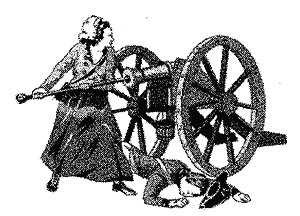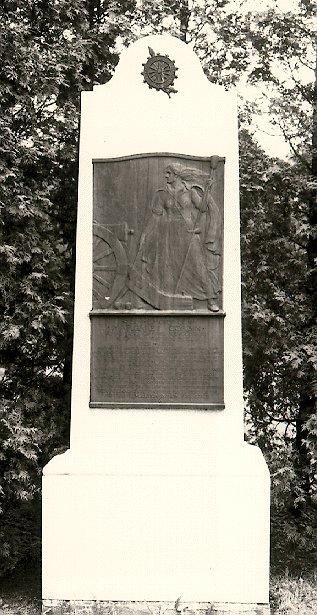|
Muzzle Blasts Online |
|
...for the muzzleloading enthusiast |
|
The muzzleblasts.com domain, subdomains, content, etc., are neither affiliated with the NMLRA nor its paper magazine Muzzle Blasts |
|
Muzzle Blasts Online |

|
|
|
|
|
|
Captain Molly

|
Washington was in favor of evacuating the fort; however, his trusted aide, General Nathanael Green, convinced him that it could be defended and proceeded to reinforce the garrison. Supplies and ammunition had been ferried across the river and transported up a steep path.
Now a force of British and Hessian soldiers were closing in on Fort Washington along the Dobbs Ferry and New Rochelle roads.
Fort Tryon was a small, outer redoubt of Fort Washington, strategically situated to delay attack on the main stockade. The redoubt was manned by Captain Thomas Proctor's 1st Company of Pennsylvania Artillery. Among the men in Proctor's battery was an Irish cannoneer named John Corbin. Corbin's wife, Margaret, was also at the redoubt.
It was not unusual to find wives and unattached females in the American encampments. Although General Washington did not approve of their presence, he came to recognize that the domestic chores the women did--cooking, mending, washing clothes, nursing the sick and wounded--greatly added to the comfort of the men. In return, the women received shelter and food. Despite the commendable service they performed, they were looked down upon by society and even today, "camp follower" is a derogatory term.
Margaret Corbin was born November 12, 1751, in Franklin County, Pennsylvania, the daughter of Robert Cochran. When she was five, Indians raided the family farm, killing her father and taking her mother captive. Margaret and her brother, who had been away from home that day, escaped harm. Nothing was ever heard of the mother, and the orphaned children were brought up by relatives.
In 1772, Margaret married John Corbin, a Virginia farmer. Three years later, John enlisted, and Margaret, refusing to be left at home, rolled her meager belongings in a blanket and went with her husband.

|
|
Captain Molly, from a water color by Herbert Knotel, Courtesy of West Point Museum, United States Military Academy, West Point, New York and David Meschutt, Curator of Art, West Point Museum. |
On the afternoon of November 16, Fort Tryon was attacked by Hessian infantry, led by Lt. Gen. Wilhelm Baron von Knyphausen. For several hours, the American artillery kept the mercenaries at bay. Then a sudden burst of grapeshot from enemy lines sprayed Proctor's valiant gunners. John Corbin and the rest of the gun crew fell dead or wounded. Molly rushed to the aid of her husband, but there was nothing she could do. He had given his life in the fight for liberty.
Like any well-trained solider, Molly snatched up the long rammer. Perhaps anger overcame anguish at that moment. She took her battle station, cleaning and loading the cannon with the help of the wounded men, and firing at the advancing line of Hessians until another round of grapeshot ripped into the small defensive force.
As the enemy overran the American battery, Margaret lay beside the now still cannon. Two balls had struck her in her breast and shoulder and one more had nearly severed her left arm. Blood ran from her left cheek.
Perhaps because she was a woman, Molly was spared the fate that befell many of her comrades--death from a Hessian bayonet. Why she didn't bleed to death on the battlefield or die of gangrene is an unanswered question. When Fort Washington fell, Margaret was taken prisoner but soon after was turned over to the American Army.
In what must have been an excruciating ordeal, Margaret was loaded in a straw-filled cart with other wounded and taken to the Army hospital in Philadelphia.
No records survive to indicate where Molly spent the next two-and-a-half years, but on June 26, 1779, the State of Pennsylvania awarded her $30.00 "to relieve her present necessities due to her disabled condition caused by wounds received while she filled with distinguished bravery the post of her husband who was killed by her side serving a piece of artillery at Fort Washington."
A few days later, on July 6, Congress directed that "Margaret Corbin receive one half the monthly pay of a solider in the services of these States and that she now receive out of public stores, one suit of clothes or the value thereof in money."
Proof that Molly was on the rolls of in Invalid Corps is found in the archives at West Point. Correspondence between General Henry Knox and Quartermaster William Price from 1782 to 1790 indicates that she needed special care, being unable to bathe and dress herself.
Molly was in the care of a Mrs. Randalls, who lived in Buttermilk Falls (now called Highland Falls), a few miles from West Point. Mrs. Randalls was to be paid for the veteran's room and board, but that payment was often slow in coming. In September, 1795, Price wrote, "I am at a loss what to do with Capt. Molly. She is such an offensive person that people are unwilling to take her in charge."

|
|
Mounument to Margaret Corbin at West Point. (Photo courtesy of the US Military Academy Archives.) |
In 1800, at the age of 49, Captain Molly died and was buried in the highlands above the Hudson River, her grave marked with a crude stone marker. Her life and death might have passed into oblivion but for the stories that were handed down through generations of villagers living in Buttermilk Falls. In 1926, the New York Society, Daughters of the American Revolution, became interested and uncovered the military history of Margaret Corbin in the West Point archives and the papers of Henry Knox. The overgrown grave was located with the help of a retired riverboat captain who said his grandfather had helped with the burial. A West Point surgeon verified that the skeleton in the grave was that of a female and that the left side of the face, left shoulder, chest and upper arm were badly battered.
On April 14, 1926, Captain Molly's remains were re-interred with full military honors in the post cemetery. The DAR marked her grave with a large granite memorial and bronze plaque.
Margaret Corbin was the first American woman to be wounded on the battlefield fighting for American independence. She was also the first women to be paid a pension by the United States government for service to her country.
Margaret Corbin--"Captain Molly"--was not the only female to have played a part in the colonists' rebellion against Great Britain. Most of the stories and legends relating the bravery of these "petticoat patriots" appear as footnotes to historical accounts of the Revolutionary War. Some of the better known chronicles have to do with the wives of high-ranking officers, whose lifestyle changed little when they took a house in the vicinity of their husbands' campaigns. These women were more likely to wage war at dinners and balls than on the battlefield.
The wife of an ordinary soldier didn't have it so easy. Following her husband to camp was a desperate act prompted by the sheer necessity of feeding herself and sometimes her children. She also was more likely to be a bit "rough," and accustomed to hard work.
One of the better-known legends is that of another Molly: Mary Ludwig Hays McCauley, the famous "Molly Pitcher." Contemporary accounts reveal that at the Battle of Monmouth, New Jersey, June 28, 1778, men and horses were collapsing due to the extreme heat. The cry for water was incessant. Mary Hays, who had followed her husband's artillery company into battle, ran from one exhausted American solider to another with pitchers of water filled at a nearby spring. When her husband lay beside his cannon seriously wounded, Mary Hays took his place, helping load and fire the big gun.
Many of the biographical notes on the two Mollys are similar. Both were born in Pennsylvania; both had husbands who were in the artillery; both were awarded pensions for war-time service. Both were buried with military honors (though in the case of Captain Molly, somewhat belatedly) and had memorial stones erected in their honor. There are several memorials to "Molly Pitcher" in New Jersey and Pennsylvania.
Another fascinating legend is that of Sybil Ludington, the "female Paul Revere." On the night of April 26, 1777, the sixteen-year-old girl made a forty-mile ride on horseback to alert the militia. Word had reached her father, Colonel Ludington, that the British were burning Danbury, Connecticut. His militiamen were urgently needed to aid the Continentals stationed in the town and help turn back the British. The rider who had brought the message was too exhausted to go any farther.
According to tradition, Sybil mounted her horse and rode pell-mell through the towns and countryside, banging on doors with the butt of her riding crop. The British succeeded in sacking Danbury, but the militia mobilized in time to drive the redcoats back to their ships in Long Island Sound.
These three stories are just a sampling of hundreds more hidden away in diaries, journals, and archives that can be summed up in the familiar phrase, "Never underestimate the power of a woman."